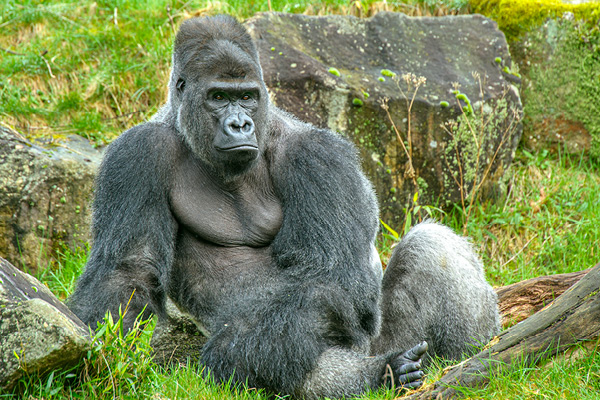Western lowland gorilla
Gorilla gorilla gorilla
Habitat
Tropical rainforest
Food
Fruits, leaves and shoots
Weight
♂ ± 180 kg | ♀ ± 70 kg
Age
45 to 50 years
IUCN Status
Ernstig bedreigd
Appearance
Gorillas are the largest, strongest and heaviest of all primates. And that’s what they look like, too! Their wide chest, muscly neck and long, muscly arms make gorillas genuine powerhouses. Gorillas have black fur. When males mature, the fur on their back and legs turns silver-grey. Which is why they’re known as ‘silverbacks’. Gorillas belong to the category of great apes that also includes orangutans, bonobos and chimpanzees. So they resemble us a lot, although there are obvious differences too. For example, gorillas walk on all fours. More specifically: on their feet and on the knuckles of their hands. The bones in their hands and wrists are especially adapted for this purpose. In addition, gorillas have a characteristically fat belly. That’s not because they’re pregnant, but because they have very long intestines. They need such long intestines to digest all the plants they eat!
Habitat
Western lowland gorillas live in the tropical rainforests of central Africa. Because they are spread across a wide area, they live in a variety of habitats, ranging from tropical rainforest to lowland and swampy forests.
Lifestyle
They live in groups of five to twenty individuals. In each group, one adult male (the silverback) is the boss. He lives in the group together with his females and their offspring. This type of group structure is known as a ‘harem’. The gorilla leader maintains peace and quiet in the group. He protects the group and decides where the group will go, for example when they go foraging for food (which takes up a large part of their day). Daughters leave the group when they are almost mature and they go off to join a different harem. Sons leave the group and live a solitary life in which they go in search of their own harem or temporarily join an all-male group known as a ‘bachelor group’. Such groups usually consist of one silverback and several young males, known as ‘blackbacks’.
Behaviour
Gorillas are very quiet and friendly animals. They often produce a soft, humming sound which tells other individuals that they are contented. But gorillas are also capable of screaming and roaring loudly. They do this, for example, when they lose sight of each other, or feel threatened or get into an argument. Often the silverback doesn’t even need this type of communication. All he has to do to control the group is adopt a certain posture, or look directly at another individual. Sometimes the silverback must act, though. If the females are at odds with each other, he usually lets them sort it out themselves. But sometimes he hits a female to correct her. It’s especially impressive to see a silverback beating his chest. Which he might do to intimidate another silverback. He then runs towards the other animal, tearing up bushes and trees on the way to demonstrate his strength and then does a drum roll by beating his chest with his flat hands. This sound is amplified by making cups out of their hands, creating a hollow space. By the way, gorillas beat their chests for other reasons too, for example when they want to play, challenge each other or boast.
Reproduction
Female gorillas become fertile when they are about eight years old. They have their first baby when they are about ten. They usually give birth at night. The new mother then rests for a few hours and goes out with the group again the very next day. The newly born infant is very small and only weighs two kilos. Gorilla babies hold on tightly to their mother’s fur using their hands and feet. Mothers initially carry their infants on their belly and later on their back or on an arm or leg. Young gorillas suckle milk from their mother for four or five years. During the first years of their life, you can recognise gorilla young by the tuft of white hair on their buttocks. This tuft is a clear signal to the other members of the group to treat the young gorilla kindly. The white tuft means something like: “I’m young so I can still do whatever I please.” The white tuft disappears when gorillas reach puberty, by age five or six. After that they must abide by all the rules and the hierarchy in the group. Males become sexually mature relatively young. They only finish maturing, however, by the time they are about eighteen. Their weight doubles between the ages of twelve and eighteen. That’s when all male gorillas develop their characteristic silver-grey fur.
Situation in the wild
Western lowland gorillas are threatened with extinction. More and more of their habitat is making way for agriculture. People also hunt gorillas for their meat (bush meat). Gorillas are also affected by wars and incidents such as Ebola epidemics.

At Apenheul
In 2018 a new silverback called Bao Bao arrived at Apenheul from the Taipei Zoo in Taiwan. The European western lowland gorilla population management programme decided that he would succeed gorilla leader Jamo. In 2018 Jamo moved to a different zoo, because he had completed his job of being leader. At the end of 2023 it was time for Bao Bao to quiet down; this is why Banjoko came to Apenheul at the beginning of December that year. In 2024, both silverbacks could be seen on separate islands, together with their own group. Bao Bao passed away on May 13, 2025. He reached the age of 40.
Banjoko's group lives on the largest gorilla island in the world. They share this outdoor enclosure with the L’Hoest’s monkeys.
Population management programme
By working together with other zoos in the the European endangered species programme (EEP) for western lowland gorillas, we ensure a genetically healthy and demographically stable population of these great apes is maintained in zoos.
Fun facts
- Every evening, gorillas make a sleeping nest out of twigs and plants. They build their nest either in a tree or on the ground. That’s where they spend the night. Young gorillas sleep with their mother in her nest until they are about age three. The silverback usually sleeps on the ground.
- Gorillas are renowned for the chest-beating sound they make. They don’t do this with their fists, but rather they form their hands into cups. That way it doesn’t hurt and it also means the sound travels a lot further.
Want to see the Gorillas at Apenheul?
Get your tickets now and spot all the primate species!

Welcome to Apenheul
Open every day
from 10.00 until 16.00